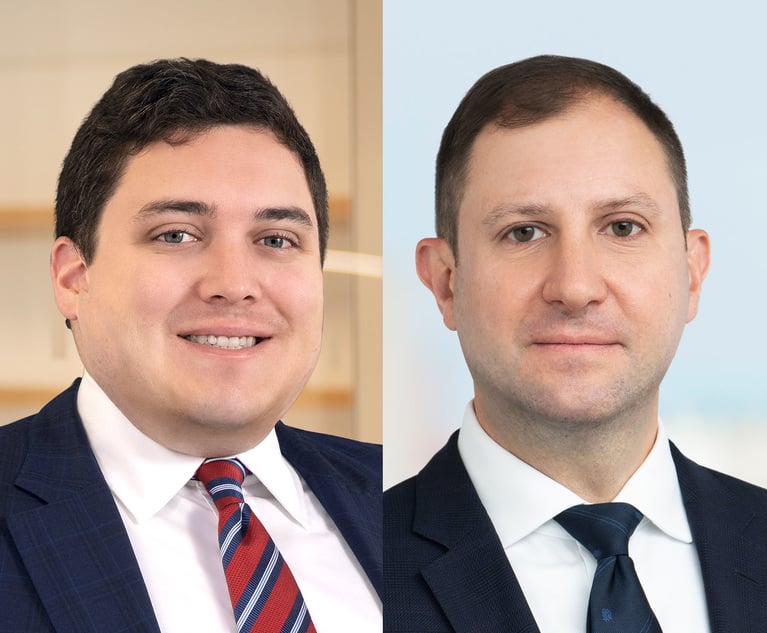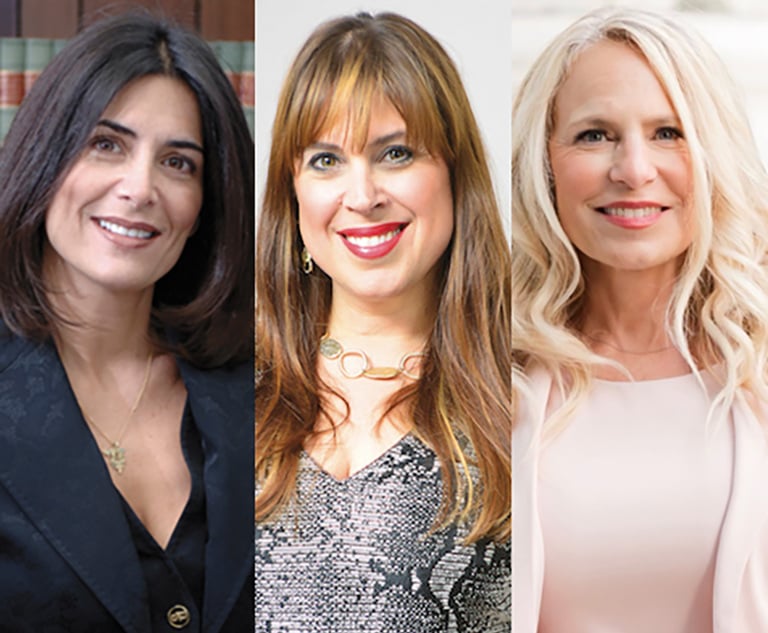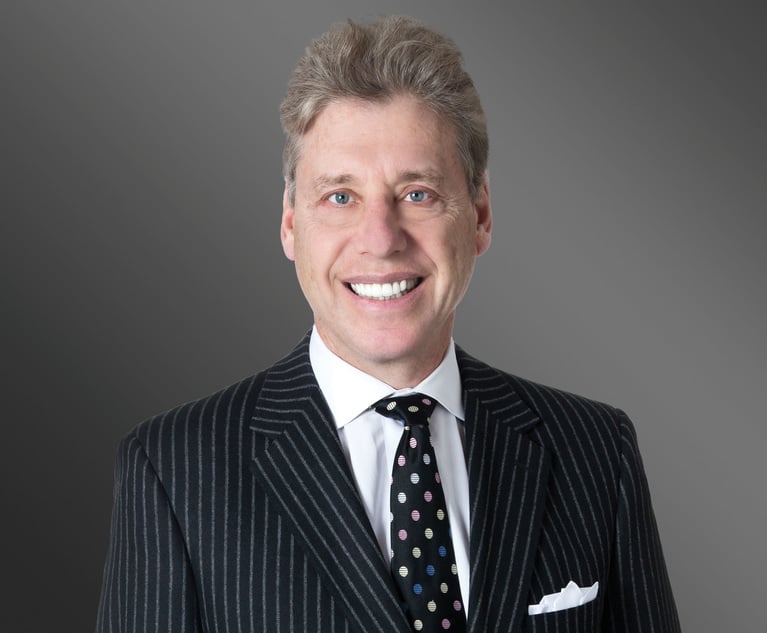More Evolution, Less Revolution: LGBTQ Rights Before NJ Courts
New Jersey case law tells us of how the LGBTQ community fought back through lawyers before our state courts.
June 20, 2019 at 12:00 PM
10 minute read
 Getty Images/iStockphoto
Getty Images/iStockphoto
June 28, 2019, marks the 50th anniversary of the Stonewall riots, a violent and raucous demonstration pushing back against a police raid at the Stonewall Inn in Greenwich Village. The rebellion is considered the start of the modern fight for LGBTQ rights in the United States, but New Jersey case law tells us of how that community fought back earlier, albeit in less dramatic fashion, through lawyers before our state courts.
If those who do not study history are condemned to repeat it, lawyers and judges have the primary responsibility to ensure that not only is the past not forgotten, but society grows and evolves from history, especially in the context of civil rights.
Written case law provides us with poignant snapshots of time gone by, recorded in the language and tradition in which it was decided. The history lesson in this article comes against the backdrop of the landmark Aug. 17, 2018, Appellate Division published decision in Moreland v. Park, 456 N.J. Super. 71 (App. Div. 2018). The unanimous panel remarked on the historical inequality that has impacted LGBTQ residents of the Garden State thus:
The notion of same-sex couples and their children constituting a 'familial relationship' worthy of legal recognition was considered by a significant number of our fellow citizens as socially and morally repugnant and legally absurd. The overwhelming number of our fellow citizens now unequivocally reject this shameful, morally untenable bigotry; our laws, both legislatively and through judicial decisions, now recognize and protect the rights of LGBTQ people to equal dignity and treatment under law.
Id. at 83–84. Those words of legal equality for LGBTQ people are a new fixture in New Jersey decisional law. Looking back just 60 years, the journey toward equality for the LGBTQ New Jerseyans was long and rough, begun many years prior by the few courageous advocates who dared to speak out on their behalf.
This analysis could start well before 1956 but we begin then, right in the heart of Asbury Park at a gay bar, a frequent target of law enforcement in the broader scheme of LGBTQ oppression. It was April 6, 1956, and the State Division of Alcoholic Beverage Control (“ABC”) commenced a series of inspections of Paddock Bar at 810-812 Cookman Avenue. At a May 4, 1956, enforcement proceeding, the ABC charged:
On April 6, 7, 8, 21 and 22, 1956, you allowed, permitted and suffered your licensed place of business to be conducted in such manner as to become a nuisance in that you allowed, permitted and suffered female impersonators and persons who appeared to be homosexuals in and upon your licensed premises; allowed, permitted and suffered such persons to frequent and congregate in large numbers in and upon your licensed premises; and otherwise conducted your place of business in a manner offensive to common decency and public morals.
Paddock Bar v. Div. of Alcoholic Beverage Control, 46 N.J. Super. 405, 407 (1957).
At trial, Paddock Bar was found in violation and shuttered for 60 days for allowing alleged “homosexuals” to “congregate.” They appealed the ruling to the Appellate Division where the court held that their role was to support the ABC and “discourage and prevent not only lewdness, fornication, prostitution, but all forms of licentious practices and immoral indecency on the licensed premises. The primary intent of the regulation is to suppress the Inception of any immoral activity, not to withhold disciplinary action until the actual consummation of the apprehended evil.” Id. at 408 citing In re Schneider, 12 N.J. Super. 449 (App. Div. 1951). (Emphasis added.)
The appellate judges equated the allegedly gay patrons at Paddock Bar with an “adult vagabond, ex-convict, sexual deviate, or prostitute.” Id. Even though the appeals court found that there was insufficient support in the record to uphold the charged violation, the panel found them in violation because the men at Paddock Bar acted effeminate which, in 1957, was a hallmark of a gay man at a gay bar:
True, in the present proceeding the evidence was not of the probative quality to establish beyond uncertainty that the specified patrons of the tavern were in actuality homosexuals. Neither was there any proof that any of such individuals indulged in any licentious solicitations on the premises … [t]he appellant was charged with the misconduct of permitting persons who conspicuously displayed by speech, tone of voice, bodily movements, gestures, and other mannerisms the common characteristics of homosexuals habitually and in inordinate numbers (on one occasion, as many as 45) to congregate at the tavern, which, incidentally, was advertised to be “the gayest spot in town.”
Id. The court specifically remarked on the necessity of a public policy to prevent gay men from socializing in public, finding “it is inimical to the preservation of our social and moral welfare to permit public taverns to be converted into recreational fraternity houses for homosexuals or prostitutes.” Id. The panel added, “[i]t is the policy and practice of the Division of Alcoholic Beverage Control to nip reasonably apprehended evils while they are in the bud.” Id.
Getting around a distinct lack of facts in the record to support the charged violation that the bar patrons were actually gay, the appellate court determined that a “detailed recitation of the informational testimony submitted to the director need not be undertaken.” Id. (Emphasis added.) The reason was simple, according to the unanimous court: “If the evidence here failed adequately to prove that the described patrons were in fact homosexuals, it certainly proved that they had the conspicuous guise, demeanor, carriage, and appearance of such personalities. It is often in the plumage that we identify the bird.” Id. at 408-409. (Emphasis added.)
This 1957 court panel felt compelled to actually describe the “plumage” of gay men:
Illustrative in part is the evidence that these congregated males in a noticeably effeminate pitch of voice addressed each other affectionately as “dearie, honey, doll, and darling.” One was overheard to remark, “Well, I think I will wait for my husband.” One of the inquisitive investigating agents inquired of the bartender as he ordered a drink, “What are all these guys in here, queers?” The bartender surveyed the customers and replied, “Most of them are.” They are said to have manipulated their cigarettes, giggled, and rocked and swayed their posteriors in a maidenly fashion.
Id. at 409. Thus, nearly 62 years prior to the sweeping analysis and landmark holding of LGBTQ equality found in Moreland v. Park, the Appellate Division took a mere nine days after oral arguments to affirm the violation and penalty against Paddock Bar in the admitted absence of facts based on a stereotypical caricature of gay men as they were standing around drinking at a licensed premises.
Fast-forward a decade to Sept. 11-12, 1967—two years before Stonewall and two months after the July 12-17, 1967, Newark riots—the New Jersey Supreme Court heard from six lawyers in three consolidated cases involving enforcement of morality laws against three gay bars: One Eleven Liquors in New Brunswick, Val's Bar in Atlantic City, and Murphy's Tavern in Newark. The ABC sought to “discipline[] the appellants for permitting apparent homosexuals to congregate at their licensed premises.” One Eleven Liquors v. Division of Alcoholic Beverage Control, 50 N.J. 329, 330 (1967). (Emphasis added.)
The NJ Supreme Court took just shy of two months to issue a unanimous opinion that, for the very first time in state history, allowed “well behaved apparent homosexuals” to congregate in bars. Id. at 341.
The case focused on the ABC investigator's observation at each bar:
They were conversing and some of them in a lisping tone of voice, and during certain parts of their conversations they used limp-wrist movements to each other. One man would stick his tongue out at another and they would laugh and they would giggle. They were very, very chummy and close. When they drank their drinks, they extended their pinkies in a very dainty manner. They took short sips from their straws; took them quite a long time to finish their drinks ….They were very, very endearing to one another, very very delicate to each other …. They looked in each other's eyes when they conversed. They spoke in low tones like an effeminate male. When walking, getting up from the stools, they very politely excused each other, hold on to the arm and swish and sway down to the other end of the bar and come back. … [T]heir actions and mannerisms and demeanor appeared to me to be males impersonating females, they appeared to be homosexuals commonly known as queers, fags, fruits and other names.
Id. at 334. The NJ Supreme Court noted that, “there was no charge nor any substantial evidence at the hearing before the director that lewd or immoral conduct was permitted at the licensed premises [and] … for the most part the patrons were “normally dressed” and showed “very good behavior.” Id.
In trying to understand gay men, the 1967 Supreme Court turned to the scholarly publications of the day which discussed that
[A]lthough such establishments are sometimes condemned as breeding grounds of homosexuality, the charge is not convincing. Most of the people who go there (apart from tourists and some “straight” friends) already are involved in the homosexual life. Anyone who wanders in and who is offended by what he sees is perfectly free to leave. The authors of a recent “view from within” emphasize that although an increase in homosexuality may increase the demand for homosexual bars, the bars can scarcely be said to produce homosexuals. Indeed, as these writers go on to suggest, the bars serve to keep homosexuals “in their place”—out of more public places and, to a certain extent, beyond the public view.
Id. at 336. It is fascinating to think that the New Jersey Supreme Court arrived at LGBTQ equality as a vehicle to advance the societal goal of keeping “persons of known homosexual tendencies” out of sight of the general public and together in a room, drunk. They held:
[T]hough in our culture homosexuals are indeed unfortunates, their status does not make them criminals or outlaws. So long as their public behavior violates no legal proscriptions they have the undoubted right to congregate in public. And so long as their public behavior conforms with currently acceptable standards of decency and morality, they may, at least in the present context, be viewed as having the equal right to congregate within licensed establishments.”
Id. Thus, LGBTQ equality began in New Jersey in 1967 with our State Supreme Court declaring equal rights for gay men to be allowed to drink in the same room because it kept them out sight.
Written case law memorializes historic mistreatment of LGBTQ people before the courts and recites important civil rights history we must all understand, appreciate, and build on. Indeed, it is essential so that we can guard against a return to those days of oppression and be better advocates as we bend the moral arc of the universe toward justice for the LGBTQ community.
Thomas H. Prol is a past president of the NJ State Bar Association and the first openly gay leader in its history. He is founding and current board member of Garden State Equality, the largest LGBTQ rights organization in New Jersey and serves in the American Bar Association House of Delegates.
This content has been archived. It is available through our partners, LexisNexis® and Bloomberg Law.
To view this content, please continue to their sites.
Not a Lexis Subscriber?
Subscribe Now
Not a Bloomberg Law Subscriber?
Subscribe Now
NOT FOR REPRINT
© 2025 ALM Global, LLC, All Rights Reserved. Request academic re-use from www.copyright.com. All other uses, submit a request to [email protected]. For more information visit Asset & Logo Licensing.
You Might Like
View All
Neighboring States Have Either Passed or Proposed Climate Superfund Laws—Is Pennsylvania Next?
7 minute read
An Overview of Proposed Changes to the Federal Rules of Procedure Relating to the Expansion of Remote Trial Testimony
15 minute readTrending Stories
Who Got The Work
J. Brugh Lower of Gibbons has entered an appearance for industrial equipment supplier Devco Corporation in a pending trademark infringement lawsuit. The suit, accusing the defendant of selling knock-off Graco products, was filed Dec. 18 in New Jersey District Court by Rivkin Radler on behalf of Graco Inc. and Graco Minnesota. The case, assigned to U.S. District Judge Zahid N. Quraishi, is 3:24-cv-11294, Graco Inc. et al v. Devco Corporation.
Who Got The Work
Rebecca Maller-Stein and Kent A. Yalowitz of Arnold & Porter Kaye Scholer have entered their appearances for Hanaco Venture Capital and its executives, Lior Prosor and David Frankel, in a pending securities lawsuit. The action, filed on Dec. 24 in New York Southern District Court by Zell, Aron & Co. on behalf of Goldeneye Advisors, accuses the defendants of negligently and fraudulently managing the plaintiff's $1 million investment. The case, assigned to U.S. District Judge Vernon S. Broderick, is 1:24-cv-09918, Goldeneye Advisors, LLC v. Hanaco Venture Capital, Ltd. et al.
Who Got The Work
Attorneys from A&O Shearman has stepped in as defense counsel for Toronto-Dominion Bank and other defendants in a pending securities class action. The suit, filed Dec. 11 in New York Southern District Court by Bleichmar Fonti & Auld, accuses the defendants of concealing the bank's 'pervasive' deficiencies in regards to its compliance with the Bank Secrecy Act and the quality of its anti-money laundering controls. The case, assigned to U.S. District Judge Arun Subramanian, is 1:24-cv-09445, Gonzalez v. The Toronto-Dominion Bank et al.
Who Got The Work
Crown Castle International, a Pennsylvania company providing shared communications infrastructure, has turned to Luke D. Wolf of Gordon Rees Scully Mansukhani to fend off a pending breach-of-contract lawsuit. The court action, filed Nov. 25 in Michigan Eastern District Court by Hooper Hathaway PC on behalf of The Town Residences LLC, accuses Crown Castle of failing to transfer approximately $30,000 in utility payments from T-Mobile in breach of a roof-top lease and assignment agreement. The case, assigned to U.S. District Judge Susan K. Declercq, is 2:24-cv-13131, The Town Residences LLC v. T-Mobile US, Inc. et al.
Who Got The Work
Wilfred P. Coronato and Daniel M. Schwartz of McCarter & English have stepped in as defense counsel to Electrolux Home Products Inc. in a pending product liability lawsuit. The court action, filed Nov. 26 in New York Eastern District Court by Poulos Lopiccolo PC and Nagel Rice LLP on behalf of David Stern, alleges that the defendant's refrigerators’ drawers and shelving repeatedly break and fall apart within months after purchase. The case, assigned to U.S. District Judge Joan M. Azrack, is 2:24-cv-08204, Stern v. Electrolux Home Products, Inc.
Featured Firms
Law Offices of Gary Martin Hays & Associates, P.C.
(470) 294-1674
Law Offices of Mark E. Salomone
(857) 444-6468
Smith & Hassler
(713) 739-1250








